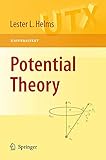Potential Theory / edited by Lester L. Helms.
Tipo de material: TextoSeries UniversitextEditor: London : Springer London, 2009Descripción: recurso en líneaTipo de contenido:
TextoSeries UniversitextEditor: London : Springer London, 2009Descripción: recurso en líneaTipo de contenido: - texto
- computadora
- recurso en línea
- 9781848823198
- QA404.7-405
Springer eBooks
Preliminaries -- Laplace's Equation -- The Dirichlet Problem -- Green Functions -- Negligible Sets -- Dirichlet Problem for Unbounded Regions -- Energy -- Interpolation and Monotonicity -- Newtonian Potential -- Elliptic Operators -- Apriori Bounds -- Oblique Derivative Problem.
Aimed at graduate students and researchers in mathematics, physics, and engineering, this book presents a clear path from calculus to classical potential theory and beyond, moving the reader into a fertile area of mathematical research as quickly as possible. The author revises and updates material from his classic work, Introduction to Potential Theory (1969), to provide a modern text that introduces all the important concepts of classical potential theory. In the first half of the book, the subject matter is developed meticulously from first principles using only calculus. Commencing with the inverse square law for gravitational and electromagnetic forces and the divergence theorem of the calculus, the author develops methods for constructing solutions of Laplace’s equation on a region with prescribed values on the boundary of the region. The second half addresses more advanced material aimed at those with a background of a senior undergraduate or beginning graduate course in real analysis. For specialized regions, namely spherical chips, solutions of Laplace’s equation are constructed having prescribed normal derivatives on the flat portion of the boundary and prescribed values on the remaining portion of the boundary. By means of transformations known as diffeomorphisms, these solutions are morphed into local solutions on regions with curved boundaries. The Perron-Weiner-Brelot method is then used to construct global solutions for elliptic partial differential equations involving a mixture of prescribed values of a boundary differential operator on part of the boundary and prescribed values on the remainder of the boundary.
Para consulta fuera de la UANL se requiere clave de acceso remoto.


